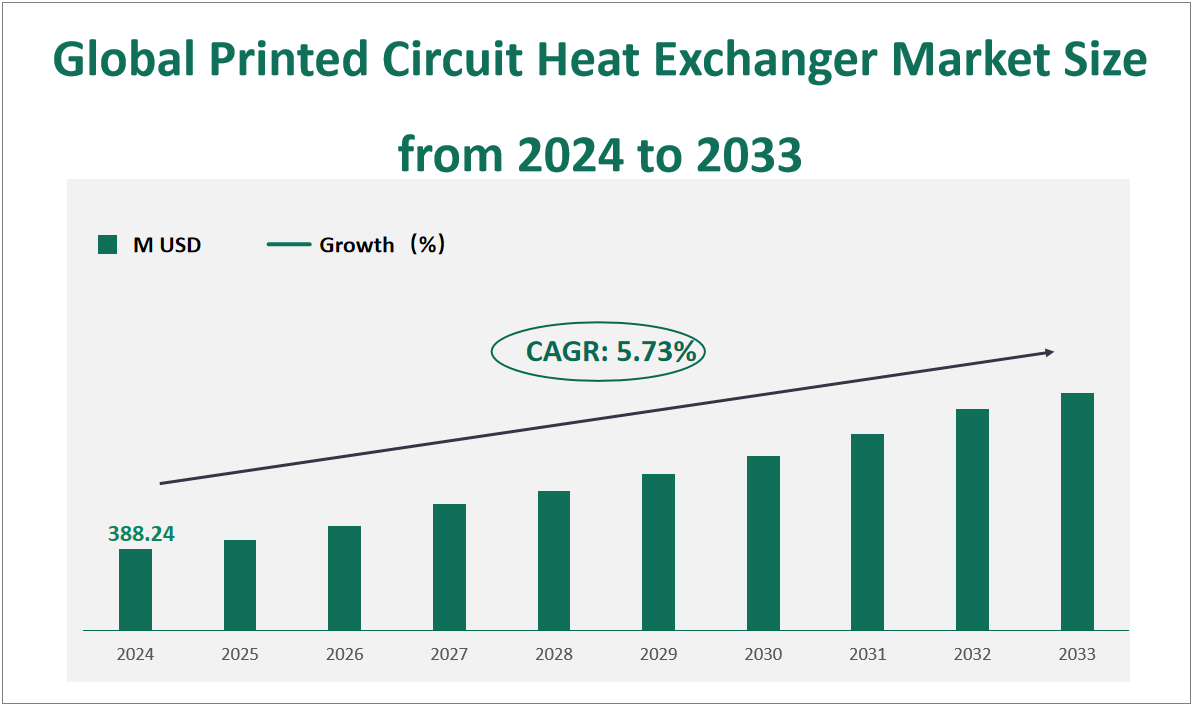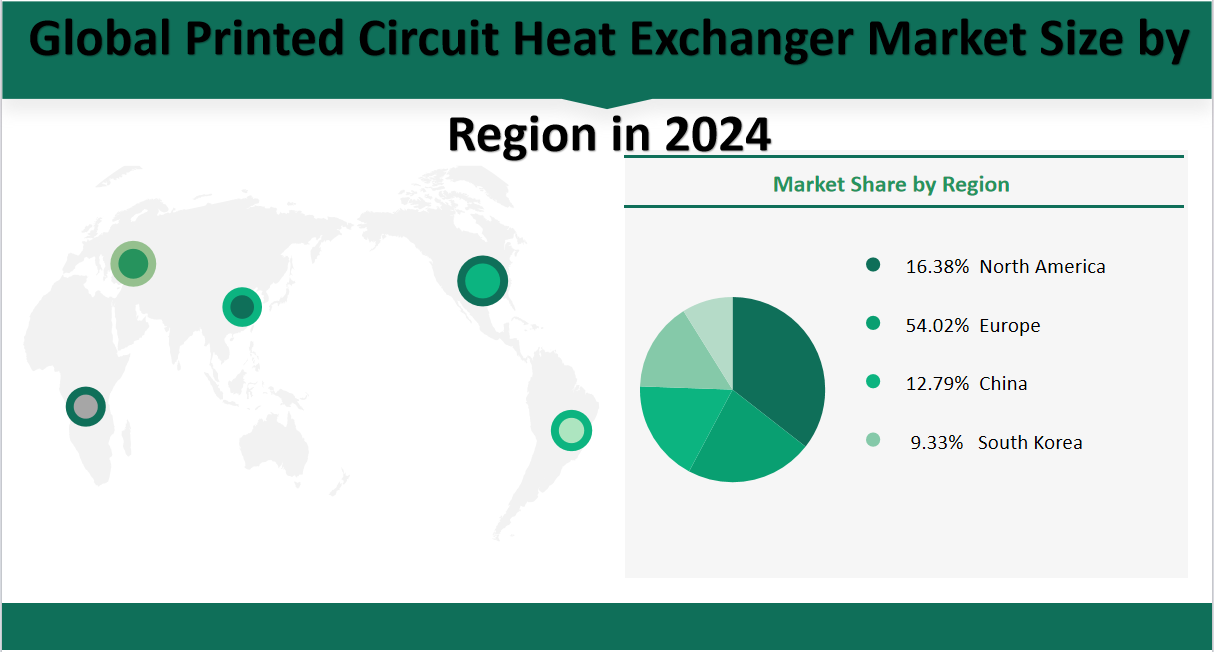1 Global Printed Circuit Heat Exchanger Market Outlook
The global Printed Circuit Heat Exchanger market is projected to exhibit substantial growth in the coming years, with a CAGR of 5.73% from 2024 to 2033, reaching a total market size of $388.24 million USD in 2024. The Printed Circuit Heat Exchanger is a relatively new process heat transfer option. The product is manufactured using a chemical milling process, the same process used for printed circuit boards. The Printed Circuit Heat Exchanger is a highly robust, highly compact plate heat exchanger with a unique construction process that makes it ideal for high pressure, high temperature applications.
Figure Global Printed Circuit Heat Exchanger Market Size and Growth Rate (2024-2033)

2 Printed Circuit Heat Exchanger Market Growth Drivers and Constraints
The growth of the Printed Circuit Heat Exchanger (PCHE) market is primarily driven by the advantages of PCHEs, which offer optimized flow patterns and heat loads, resulting in very efficient and high-performance heat transfer. These exchangers can handle gas, liquid, and two-phase flow, and can achieve approach temperatures of nearly 2°C within a single countercurrent exchanger, often eliminating the need for multiple exchangers or enclosures. According to research data, PCHEs boast a thermal efficiency of about 98%, enabling small temperature difference heat transfer and reducing irreversible losses. Their high heat transfer surface area per unit volume leads to a reduction in weight, space, and support structure, making them four to six times smaller and lighter than traditional shell and tube units, and in some cases, more than 70% smaller in size and weight compared to shell and tube heat exchangers. Additionally, PCHEs offer many safety and reliability benefits with a much lower fluid inventory than traditional exchangers. However, the market for PCHEs faces certain restraints, such as being relatively expensive and prone to clogging due to their thin channels, which require clean fluids and careful commissioning to avoid blockages. These limitations, along with the pressure drop challenges for low-pressure drop, high-volume flow applications, are factors that could hinder the industry’s growth. Despite these constraints, the wide application of PCHEs in the oil and gas industry market, driven by the continuous expansion of the petrochemical market, is expected to increase the market demand for PCHEs, making it one of the important driving factors for the industry’s development.
3 Printed Circuit Heat Exchanger Market M&A Activities
In 2022, the global Printed Circuit Heat Exchanger market experienced significant consolidation among the top players, with mergers and acquisitions playing a crucial role in shaping the competitive landscape. Notably, Alfa Laval, a leading provider of tank cleaning services, expanded its product portfolio by acquiring Scanjet, which complements its existing Framo cargo pumping solutions for cargo handling. This strategic move aims to optimize tank management for customers, reducing water and fuel consumption, and ultimately lowering their CO2 footprint. Additionally, Parker-Hannifin Corporation, a global leader in motion and control technologies, completed its acquisition of Meggitt PLC for approximately £6.3 billion. Meggitt, with its diverse aerospace and defense exposure and a presence on almost every major aircraft platform, bolsters Parker’s global reach and product offerings. Furthermore, Clean Energy Systems, Inc., known for its game-changing technology in the power industry, plans to acquire the idled Madera Biomass Power Plant to convert it into a biomass carbon removal and storage facility (BiCRS). This acquisition aligns with the company’s mission to revolutionize the power industry by eliminating traditional exhaust stacks and making zero-emission electricity a reality. These mergers and acquisitions highlight the industry’s ongoing trend of consolidation and expansion, as companies strive to enhance their market positions and offer more comprehensive solutions to meet the evolving demands of the energy and power sectors.
4 Global Printed Circuit Heat Exchanger Market Analysis by Type
In 2024, the global forecasted revenue of Printed Circuit Heat Exchangers by type is anticipated to demonstrate a significant distribution across various materials. Stainless Steel is projected to generate the highest revenue of $258.21 million USD, maintaining its dominant position in the market with a share of 66.51%. Nickel is expected to contribute a revenue of $52.14 million USD, capturing a 13.43% share, while Cobalt Based Alloys will bring in $25.62 million USD, accounting for 6.60% of the total revenue. Copper is forecasted to generate $22.64 million USD, with a market share of 5.83%, and Titanium is projected to achieve a revenue of $29.62 million USD, claiming 7.63% of the market. The average price per unit across all types is estimated to be $66,513 USD, indicating a continued demand for these materials in the production of Printed Circuit Heat Exchangers. These figures underscore the diverse application and material preferences in the global heat exchanger market, with each type catering to specific industry needs and performance requirements.
Table Global Printed Circuit Heat Exchanger Market Size and Share by Type in 2024
Type | Market Size in 2024 (M USD) | Market Share in 2024 (%) |
|---|---|---|
Stainless Steel | 258.21 | 66.51% |
Nickel | 52.14 | 13.43% |
Cobalt Based Alloys | 25.62 | 6.60% |
Copper | 22.64 | 5.83% |
Titanium | 29.62 | 7.63% |
5 Global Printed Circuit Heat Exchanger Market Analysis by Application
In 2024, the global forecasted revenue for Printed Circuit Heat Exchangers by application is expected to show a concentrated distribution among key sectors. The Hydrocarbon Processing sector is projected to lead with a revenue of $351.11 million USD, holding a significant market share of 90.44%. The Hydrogen Refueling Station segment is anticipated to generate $22.65 million USD, capturing a 5.83% share of the market. Other applications are expected to contribute $14.47 million USD, which corresponds to a 3.73% share. These figures highlight the predominant role of the hydrocarbon processing industry in driving the demand for Printed Circuit Heat Exchangers, while the hydrogen refueling and other sectors also play a role in the overall market revenue. The revenue shares indicate the importance of these applications in the context of the broader heat exchanger market, reflecting the specific needs and growth potential of each segment.
Table Global Printed Circuit Heat Exchanger Market Size and Share by Application in 2024
Application | Market Size in 2024 (M USD) | Market Share in 2024 (%) |
|---|---|---|
Hydrocarbon Processing | 351.11 | 90.44% |
Hydrogen Refueling Station | 22.65 | 5.83% |
Others | 14.47 | 3.73% |
6 Global Printed Circuit Heat Exchanger Market Analysis by Region
In 2024, the global forecasted production of Printed Circuit Heat Exchangers (PCHE) by region indicates a substantial output across major regions. Europe is projected to have the highest production with 3,209 units, followed by North America with 954 units, and China with 742 units. South Korea is anticipated to produce 543 units, while other regions are estimated to contribute 389 units to the global production. When it comes to market share, Europe is expected to maintain a significant position with a 54.02% share of the global production, demonstrating its prominence in the PCHE market. North America will hold a 16.38% share, China will account for 12.79%, South Korea will have 9.33%, and other regions will collectively represent 6.78% of the total production. These figures underscore the geographic distribution of PCHE production and the importance of each region in meeting the global demand for these heat exchangers.
Figure Global Printed Circuit Heat Exchanger Market Share by Region in 2024

7 Top 3 Companies of Global Printed Circuit Heat Exchanger Market
7.1 Meggitt PLC
Company Introduction and Business Overview:
Meggitt PLC, established in 1850, is a global leader in the aerospace, defense, and energy industries. The company specializes in advanced polymers and composites, aircraft braking systems, thermal management, fluid and pneumatic controls, and more.
Products Offered:
Meggitt’s Heatric division is renowned for its diffusion-bonded heat exchangers, including Printed Circuit Heat Exchangers (PCHE). These products are known for their high integrity, operational savings, and multi-process integration capabilities.
Sales Revenue in the Latest Year:
Meggitt PLC reported a revenue of $159.02 million USD from its PCHE division, showcasing its strong market presence and revenue generation capabilities in the PCHE market.
7.2 Alfa Laval
Company Introduction and Business Overview:
Alfa Laval, founded in 1883, is a Swedish company with a global presence. Initially providing centrifugal separation solutions for dairy products, Alfa Laval has expanded into various heavy industries, including heating, cooling, separation, and transportation of various fluids.
Products Offered:
Alfa Laval’s PCHEs are recognized for their superior robustness, high heat transfer rates, and customization capabilities. They operate efficiently in temperatures ranging from cryogenic to 980°C, making them suitable for a wide range of applications.
Sales Revenue in the Latest Year:
Alfa Laval achieved a revenue of $62.78 million USD from its PCHE segment, indicating its significant contribution to the company’s overall revenue.
7.3 Innowill
Company Introduction and Business Overview:
Established in 2005, Innowill has focused on the R&D and production of high-performance compact heat exchangers. The company developed Korea’s first PCHE and collaborates with industry and academic institutions to provide optimal high-temperature, high-efficiency compact heat exchangers.
Products Offered:
Innowill’s Primary Surface Heat Exchanger (PSHE) is known for its wide heat transfer surface per unit volume and excellent corrosion resistance, making it ideal for waste heat recovery and various applications from residential to large-scale energy supply systems.
Sales Revenue in the Latest Year:
Innowill reported a revenue of $21.77 million USD from its PCHE products, reflecting its growing market share and financial performance in the PCHE industry.

